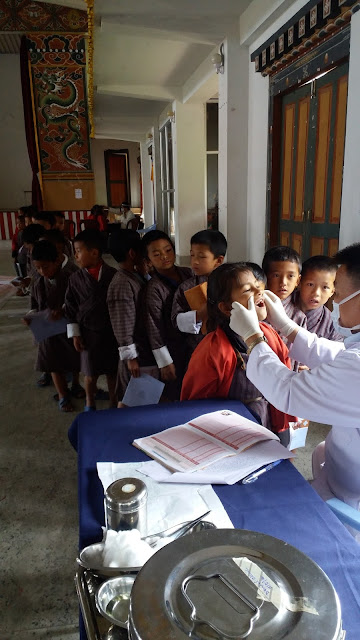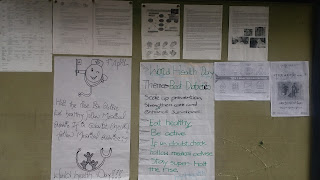 |
| Old red tego |
A kira, woonju, tego, gho, or shoes and
socks may not be the ingredients for my favorite outfit, but if I were given
a choice, I wouldn't throw away the idea of school uniform. Wearing a uniform
is a badge of pride, creates an identity for a school, and is an important part
of being a school student.
Uniforms show that you are part of
an organization. Wearing it says we're all in this together. Also, if you wear
your uniform with pride, it means you are halfway there to being respectful.
| Old Dress |
I feel uniforms are great social
equalizer. It discourages inappropriate dress, helps bolster school and
academic pride, and is a no-brainer when you get dressed in the morning.
I was told by one of the parents in
the morning, “My kids go to the school and uniforms were the best thing that
happened. They don’t see friends having better clothes, and in the end, you can
save a lot of money.”
I also feel that uniforms give
students a sense of belonging to a particular school and create an identity for
the school in the community.
 |
| New faded ash tego |
Some people believe that a school
uniform can improve learning by reducing distraction, sharpening focus on
schoolwork and making the classroom a more serious environment, allowing
students to perform better academically.
Perhaps most importantly, a uniform
means students don't have to worry about peer pressure when it comes to their
clothes. When everyone is dressed the same, worrying about what you look like
isn't so important. There is no competition about being dressed in the latest
trend, which would put a great deal of financial pressure on students and
parents. Potential bullies have one less target for their insults; it's hard to
make fun of what someone is wearing when you're dressed exactly the same.
In America, where a majority of
schools do not have a uniform, roughly 160,000 children miss school every day
due to fear of attack or intimidation by other students. This might not be
directly linked to what they're wearing, but having a uniform can be a safety
net for many students who might otherwise suffer from bullying. A strict
uniform gives the impression that rules are strict too, perhaps helping
maintain a sense of order at school.
 |
| New dress |
The pros and cons of school uniforms
According to the proponents, school
uniforms:
• Encourage discipline
• Help students resist peer pressure to buy trendy clothes
• Help identify intruders in the school
• Diminish economic and social barriers between students
• Increase a sense of belonging and school pride
• Improve attendance
• Encourage discipline
• Help students resist peer pressure to buy trendy clothes
• Help identify intruders in the school
• Diminish economic and social barriers between students
• Increase a sense of belonging and school pride
• Improve attendance
Opponents contend that school
uniforms:
•
Violate a student’s right to freedom of expression
• Are simply a Band-Aid on the issue of school violence
• Make students a target for bullies from other schools
• Are a financial burden for poor families
• Are an unfair additional expense for parents who pay taxes for a free public education
• Are difficult to enforce in public schools
• Are simply a Band-Aid on the issue of school violence
• Make students a target for bullies from other schools
• Are a financial burden for poor families
• Are an unfair additional expense for parents who pay taxes for a free public education
• Are difficult to enforce in public schools
Darla school changed its girls' dress
for the second time in a year. Starting from this July, our girls will be wearing
ash-brown tego instead of bright red tego. A number of students have complained
about the change, and there was a general opinion about this dress as really
bad.
The red tego was lots of problems
with many students and some teachers and parents against it. It was only due to a
few persons in the school, that the red tego was to be red. Many thought it was
not good. There were many reasons saying against the bright red colour. Though
symbolically confident and bright, it had more negatives than its good ones.
The red was so intense to look at, as it affects the eyes, especially, teachers
who had to see tegos. I also heard that it attracted bulls, leeches as they
were plentiful in Darla.
The tego was chosen by our school
girls before the first term, and they like it now. One of the students said,
"I like uniforms because everyone is same and no one can be left out
by the way they are dressed. Our new tego looks smarter, which is good."
New
Principal
With the change of the tego came the change of principal. Mr. Tshochu was replaced by a new principal Mr. Tshering. The former principal went to Gedu HSS, and the latter came after his studies. Till now I have worked under seven principals, and I found Mr. Tshochu to be the best of all. Though, he was also a little crooked, and who says humans are not crooked. Everyone is. Everyone was a little bit un-human and they would lack civic sense sometimes. When I have time now, I would like to list down some good and lousy leaders:
With the change of the tego came the change of principal. Mr. Tshochu was replaced by a new principal Mr. Tshering. The former principal went to Gedu HSS, and the latter came after his studies. Till now I have worked under seven principals, and I found Mr. Tshochu to be the best of all. Though, he was also a little crooked, and who says humans are not crooked. Everyone is. Everyone was a little bit un-human and they would lack civic sense sometimes. When I have time now, I would like to list down some good and lousy leaders:
Lack of Transparency; we(i) can tell when someone is not being completely
honest. There’s rarely a reason not to be entirely transparent with everyone, every time. But we appreciate an understanding of all. Lack of transparency can
result in a lack of trust.
Egoistic; the best leaders are ones who accept blame when things go wrong and give credit to their team when things go right. In order to be a true visionary leader, you need to let go of your ego and focus on your people because without them you would be nowhere.
Egoistic; the best leaders are ones who accept blame when things go wrong and give credit to their team when things go right. In order to be a true visionary leader, you need to let go of your ego and focus on your people because without them you would be nowhere.
They don’t have enough confidence to lead at their level. The boss I worked in Tsirang at the start couldn’t decide because he had no faith in his decisions.
They’re arrogant, assuming they always know what’s best. It takes confidence to lead. It also takes humility. Many
leaders think they’re confident when they’re really just pigheaded and proud.
They’re disorganized.
I’ve worked with some hard-driving, capable leaders who hamstrung themselves by
never getting organized. I had one leader like this, who ran after ladies and
bother little about school. The first thing I would do if I were boss fired
him.
They over-promise and under-deliver. This one affects more than just politicians. People leading
up in an organization often do this because they are trying to impress those
above them, failing to realize that by under-delivering they are shooting
themselves in the foot. And people at the top fall into the trap by overusing
promises as a way to ensure team loyalty. I see most leaders in Bhutan are like
that – sycophancy.
They don’t articulate a clear vision. No one wants to follow in the dark. It’s impossible to
motivate people who feel in a fog.
They don’t enroll others in their initiatives. Some leaders just expect people will follow them just
because of their position. Wrong. If a leader can’t enroll others, failure
looms.
They don’t hold people accountable—especially themselves. If a leader avoids responsibility and won’t hold their team
accountable, they’ll shipwreck the organization. Accountability is essential.
Nobody is born with any given skill, we learn through
observation and by copying others (our role-models). You might get some
valuable info from reading books on this subject, but I remember an old saying,
scribbled on the cover of a book I read in my teens: “Life is not learned from
books, but by living it.”
While meeting great leaders has always been a wonderful
experience, it is the bad ones that really enforce the true values of leadership.
I’ve been lucky in this sense, as I got the chance to meet some of the worst
leaders you can possibly imagine. Leaders who fail to keep up risk being
clueless, close-minded, and arrogant. A lack of knowledge leads to
indecision and fear and can cause employees to quickly lose trust in their
leader.






















